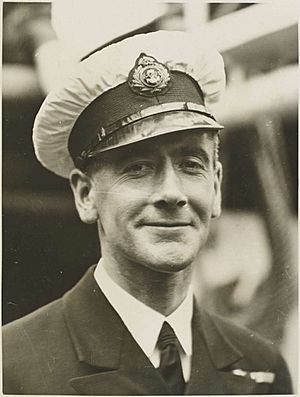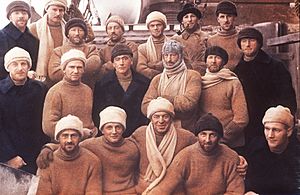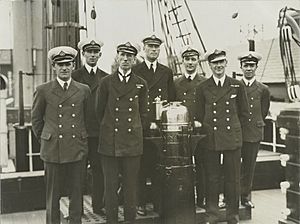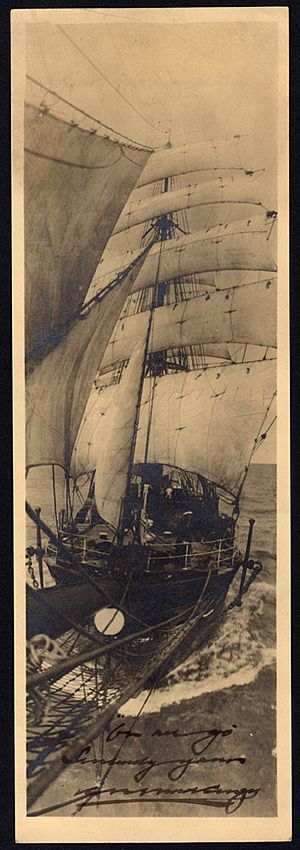Kenneth N. MacKenzie facts for kids
Quick facts for kids
Kenneth N. MacKenzie
|
|
|---|---|
 |
|
| Born | 26 November 1897 Oban, Scotland
|
| Died | 29 September 1951 (aged 53) |
| Known for | Role during exploration of Antarctica |
| Awards | Polar Medal |
Kenneth Norman MacKenzie (born November 26, 1897 – died September 29, 1951) was an important officer in the merchant navy. He is famous for his work during the British Australian and New Zealand Antarctic Research Expedition. For his efforts, he received a special award called the Polar Medal.
Contents
Early Life and School
Kenneth MacKenzie was born in Oban, Argyllshire, Scotland, in 1897. His father worked in law. Kenneth was the third of four sons.
In 1904, his parents divorced. Kenneth, his mother, and his three brothers moved to the island of Tiree. They lived with his grandfather, who was a church minister.
The boys later went to school in Kingussie, in the Scottish Highlands. They stayed with their uncle, who was also a minister. Kenneth learned to play the bagpipes there. He later became known for writing and giving talks about his adventures.
Joining the First World War
When the First World War started, Kenneth MacKenzie was one of the first to join from Tiree. He was very young, so he pretended to be older to join the army. The army found out his real age but kept him for training.
He trained for two years until he was 18. Then, he was sent to the Western Front. This was a dangerous area where many battles happened. He joined the Argyll and Sutherland Highlanders.
Just before he could become an officer, he was captured by the enemy. He was also injured by gas and buried. Luckily, he was rescued but was very unwell. He spent over a year recovering in a hospital. The war left him with lasting health problems.
A Career at Sea
After leaving the army, Kenneth joined the merchant fleet. This is a group of ships that carry goods and people around the world. He trained for a year to become a radio officer.
He sailed on many different ships. He became Chief Radio Officer on a ship called the Titan. Later, he joined the Union-Castle Line as an ordinary sailor. He worked his way up to Bosun, a senior crew member.
He then earned his certificates to become a Watch Officer and later a Master (Captain). He sailed with different shipping companies, including the Ellerman Lines.
One day, while his ship was in London, MacKenzie saw a famous wooden sailing ship. It was the Discovery. He was very excited and immediately asked for a job on it. The Discovery was getting ready for a scientific trip to Antarctica. His company, City Line, gave him time off to join the expedition. He was appointed as the ship's Chief Officer.
Antarctic Expeditions
Kenneth MacKenzie sailed as the first officer on the Discovery's first trip to Antarctica. The ship left London on August 1, 1929. It was led by Captain John Davis, a well-known explorer. MacKenzie helped train the crew, who were new to sailing ships.
The first trip was a big success. They explored the Antarctic coastline and discovered new lands. They named one area Mac. Robertson Land. The ship returned to Melbourne, Australia. In November 1930, MacKenzie took command of the Discovery as Captain Davis returned to his government job.
On the Discovery's second Antarctic journey (1930–1931), MacKenzie was the Captain. They explored more of the Antarctic Coast. They discovered and named Princess Elizabeth Land, a name MacKenzie suggested. A new area of the sea, 'MacKenzie Sea', was also named after him.
The second voyage also went very well. The ship returned to Australia in March 1931. After completing its scientific work, MacKenzie sailed the Discovery all the way back to London. The ship arrived in excellent condition in August 1931.
For his brave work in Antarctica, King George V awarded MacKenzie the Polar Medal. This special medal recognized his contributions to exploration. The MacKenzie Bay, near the Amery Ice Shelf in Antarctica, is named in his honor.
Later Life and Family
After his Antarctic adventures, MacKenzie returned to the City Line. He became Chief Officer on the steamer City of Dieppe. During a trip to Australia, he met Lillian Green, a farmer's daughter. They later got married.
In 1933, MacKenzie was asked to command a new research ship called Mabahiss. This ship was an Egyptian naval vessel. It was going to explore the Indian Ocean for scientific research. MacKenzie was given special permission to take this job. He sailed the Mabahiss from September 1933 to May 1934, conducting important research.
When he returned to London, MacKenzie worked for Ellerman Lines. He became an Assistant Marine Superintendent. Later, he joined the London, Midland and Scottish Railways. He helped manage their fleet of cross-channel ships. In 1935, he became the Harbour Master and Marine Superintendent at Holyhead in Wales. This was a busy port for mail and passenger ships traveling to Dublin.
Kenneth and Lillian MacKenzie had two daughters and one son. Although his health was never fully strong after the First World War, he enjoyed his family life. He also loved his work managing the port of Holyhead. He oversaw the ships, dry docks, and shipyard there.
In 1938, he had a heart attack. His health continued to decline, but he kept working. Kenneth MacKenzie passed away in 1951 at the age of 53.
Images for kids





